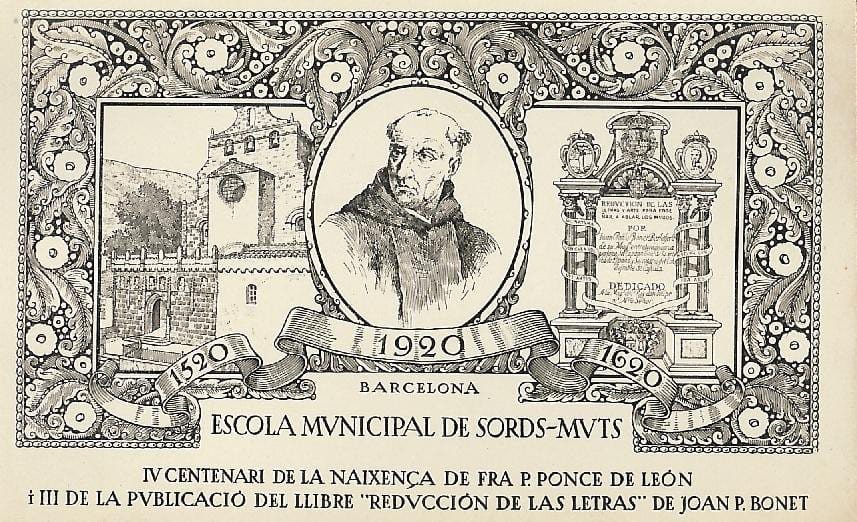Pioneer Teacher of the Deaf, Pedro de Ponce de Leon (15?–1584)
By H Dominic W Stiles, on 18 October 2013
Pedro de Ponce de Leon was a Benedictine monk who lived in the San Salvador de Ona Monastery near Burgos, where he took his vows in 1526 (Werner, 1932). (Most records perpetuate the mistake of dating his birth to 1520.) Of noble lineage himself (the Ponce de Leon family produced a number of notable people in Spanish history) he became a pioneer teacher of the deaf when he came across two aristocratic deaf boys in the care of the monastery.
Werner (1932, p. 223) says that
Pedro Ponce cannot be depicted as such an encyclopedic genius, as he is usually made out to be. It is equally incorrect to assert that from the very beginning he aimed at teaching the deaf-mutes to speak. The course of history and his own technique show that chance played a large part and that although this monk undoubtedly possessed a great deal of altruism and didactic skill, his knowledge of deaf-mutism was in many ways inaccurate, which nevertheless did not prevent him from being successful.
One brother died quite young. The boys were taught to read and speak to a fair degree by Ponce, although the chronicler and relation of the boys Baltasar de Zúñiga said of one, “Although his speech was somewhat clumsy, the subtlety of his argument compensated for this drawback.” (Werner, p.225)
Pedro went on to teach ten to twelves others to acquire some limited vocabulary, though with less success than the first two. Someone asked Pedro de Ponce how he went about teaching, and he put the question to don Pedro his pupil. Ambrosio de Morales quotes don Pedro;
You see, when I was young and as ignorant as a stone, I began to learn to write and first of all I wrote the names of object which my teacher showed me. Then I wrote all the Spanish words in a book which was provided me for this purpose. Then, with God’s help, I began to spell out and speak as loudly as I could, although a great deal of spittle came from my mouth. Afterwards I began to read stories so that in ten years I had read stories from all over the world. Later I learned Latin. This all happened by God’s great grace without which nothing can succeed. (Werner p,227)
Werner goes on to surmise what may be the realities of the case; Pedro de Ponce was interested in botany & natural history, but this could well mean he was a ‘clever gardener and grower’; the boys attached themselves to him because he was kind, not because he showed any particular interest in deafness; he only attempted to teach them speech when they were already able to write (Werner p.228-9). It seems he was accidentally lucky, and Werner points out that he cannot “have known Aristotle’s dictum concerning the impossibility of teaching deaf-mutes or otherwise he would not have gone about his task so sanguinely” (ibid). While he was a great man, a blind allegiance to Aristotle in the Middle Ages and later meant many people relied on what he said rather than on their own observations.
Ponce was unaware of the possibility of lipreading, but built on spontaneous sounds the boys produced, and did it seems use a hand alphabet and gesture (ibid p.232). The hand alphabet was, Werner speculates, possibly the same as that used later by Ramírez de Carrión and Bonet.
One of his pupils who was a success although not in speaking, was Brother Gaspar de Burgos, who became sacristan at the church of San Juan in Burgos “to the astonishment of those who associated with him and knew his secret” (ibid p.240).
Despite some success in teaching, Pedro de Ponce did not pass on his teaching to others like Juan Pablo de Bonet. Nonetheless, he remains an important figure for Deaf education in the early modern period.
You can read Werner’s full account of de Ponce and his methods in a typed translation in the library:
Werner, Hans, History of the Problem of Deaf-Mutism until the 17th Century. translated by C.K. Bonning in a typed bound manuscript in the library RNID YA 17.
Click onto the image for a better view.
 Close
Close


